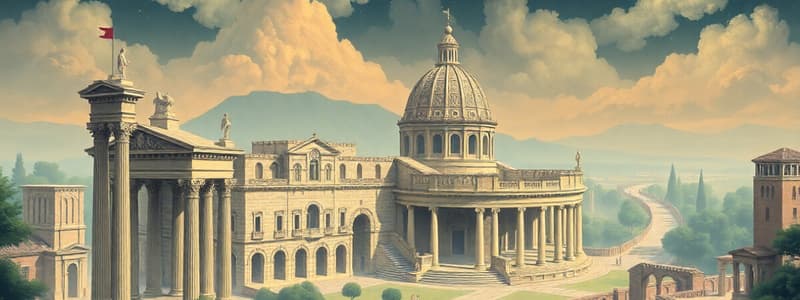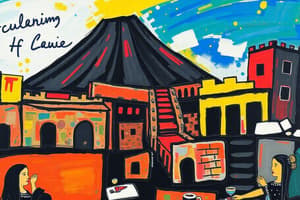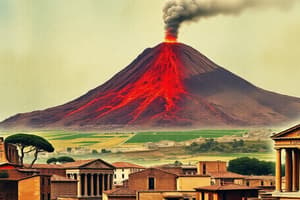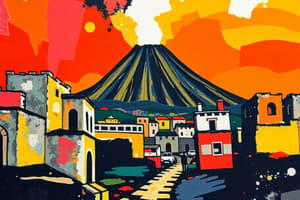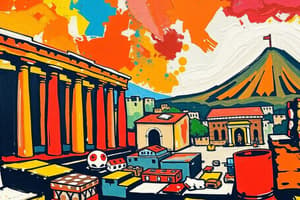Podcast
Questions and Answers
How did the eruption of Mount Vesuvius in 79 AD alter the geography of Herculaneum?
How did the eruption of Mount Vesuvius in 79 AD alter the geography of Herculaneum?
- It pushed the shoreline approximately 400 meters further out, burying the city under 20 meters of volcanic debris.
- It shifted the city further inland, creating a natural harbor.
- It resulted in the formation of a new river delta, which isolated Herculaneum from the surrounding region. (correct)
- It caused the collapse of the city's grid plan, making navigation difficult.
What is the primary significance of the boat sheds discovered in Herculaneum, beyond their use as storage?
What is the primary significance of the boat sheds discovered in Herculaneum, beyond their use as storage?
- They demonstrate the sophisticated hydraulic engineering used to manage water flow in the city.
- They provide insights into the diet and health of Herculaneum's residents through studied skeletal remains. (correct)
- They reveal advanced Roman shipbuilding techniques used in constructing warships.
- They showcase the intricate fresco paintings that adorned public spaces in the city.
What does the presence of a funerary altar and a statue replica dedicated to Marcus Nonius Balbus suggest about his role in Herculaneum?
What does the presence of a funerary altar and a statue replica dedicated to Marcus Nonius Balbus suggest about his role in Herculaneum?
- It suggests he was a religious leader who introduced a new faith to the city that lasted until the time of the eruption.
- It implies he was a praetor and benefactor who significantly contributed to the city's infrastructure and held a revered status among its residents.
- It confirms his status as a philosopher and educator who established a prominent school in Herculaneum. (correct)
- It indicates his role as a military general who defended Herculaneum against invaders centuries before the eruption.
How does the House of the Relief of Telephus reflect the cultural influences present in Herculaneum during its time?
How does the House of the Relief of Telephus reflect the cultural influences present in Herculaneum during its time?
What insight does the discovery of carbonized tree trunks within the palaestra of Herculaneum provide about the immediate impact of the volcanic eruption?
What insight does the discovery of carbonized tree trunks within the palaestra of Herculaneum provide about the immediate impact of the volcanic eruption?
What do the well-preserved thermopolia along Cardo V suggest about the daily life and social dynamics of Herculaneum?
What do the well-preserved thermopolia along Cardo V suggest about the daily life and social dynamics of Herculaneum?
How did Bourbon excavators impact the archaeological site of Herculaneum?
How did Bourbon excavators impact the archaeological site of Herculaneum?
What can be inferred from the fact that only about a quarter of Herculaneum has been excavated thus far?
What can be inferred from the fact that only about a quarter of Herculaneum has been excavated thus far?
Considering Herculaneum's grid plan and the layout of streets like the Decumanus Maximus and cardi, what does this reveal about Roman urban planning principles?
Considering Herculaneum's grid plan and the layout of streets like the Decumanus Maximus and cardi, what does this reveal about Roman urban planning principles?
Given the archaeological findings at Herculaneum regarding diet and average height, how did the health and physical stature of its residents compare to that of the 20th-century population of Naples?
Given the archaeological findings at Herculaneum regarding diet and average height, how did the health and physical stature of its residents compare to that of the 20th-century population of Naples?
Flashcards
Herculaneum
Herculaneum
An ancient city destroyed by the eruption of Mount Vesuvius in 79 AD, known for its exceptional preservation.
Pyroclastic Surges
Pyroclastic Surges
Hot, fast-moving flows of gas and volcanic matter that caused instant death in Herculaneum.
Decumanus Maximus
Decumanus Maximus
The main east-west street in Herculaneum, reflecting typical Roman city planning.
Cardi
Cardi
Signup and view all the flashcards
Marcus Nonius Balbus
Marcus Nonius Balbus
Signup and view all the flashcards
Marble Oscilla
Marble Oscilla
Signup and view all the flashcards
Palaestra
Palaestra
Signup and view all the flashcards
Thermopolia
Thermopolia
Signup and view all the flashcards
Study Notes
Herculaneum Overview
- Herculaneum, like Pompeii, was destroyed by the eruption of Mount Vesuvius in 79 AD.
- Herculaneum is smaller than Pompeii but arguably more spectacular due to better preservation.
- Some buildings still feature carbonized wooden doors and furniture.
Geography and Impact of the Eruption
- Before the eruption, Herculaneum was on a promontory jutting into the bay.
- The eruption sent pyroclastic surges that buried the city under 20 meters of volcanic debris.
- The shoreline was pushed 400 meters further out due to the eruption.
- The volcanic debris hardened, making excavation difficult.
- Only about a quarter of the site has been uncovered to date.
City Layout and Port Area
- Herculaneum had a grid plan, typical of Roman cities.
- The Decumanus Maximus was the most important street.
- Crossing the Decumanus Maximus were narrower streets called cardi.
- The ancient port area is recently paved over.
- Boat sheds with low arcades faced the beach and sea.
- These boat sheds were likely used for storage.
- Approximately 300 people who sought shelter in the boat sheds died instantly due to the pyroclastic surge.
- Forensic anthropologists studied the bones from the boat sheds
- The people of Herculaneum were remarkably healthy, with few cavities and a diet rich in fish.
- They were also taller on average than the 20th-century population of Naples.
Terrace of Marcus Nonius Balbus
- A funerary altar and a replica of a statue commemorate Marcus Nonius Balbus.
- Balbus was Herculaneum's most distinguished citizen.
- He died nearly a century before the eruption and was cremated just outside the walls.
- He had been a praetor and provincial governor who retired to Herculaneum.
- Balbus lavished his wealth on the town, building the town's Basilica and rebuilding its walls.
- Hundreds of Herculaneum's residents were descended from his freedmen and took his name.
House of the Relief of Telephus
- The House of the Relief of Telephus is named after a relief of the Greek hero Telephus.
- The atrium features L-shaped columns and a rebuilt roof.
- There are marble oscilla or decorative discs that spun in the breeze.
- This opulent residence may have been built for Marcus Nonius Balbus or a contemporary.
Palaestra
- The palaestra is an exercise yard that is still largely buried.
- Excavators found trunks of carbonized trees swept into a corner.
- A tunnel allows access to the network of tunnels dug by Bourbon excavators in the 18th century.
- The tunnels housed a fountain shaped like a Hydra, an allusion to Hercules.
Cardo V and Decumanus Maximus
- Cardo V leads towards the Decumanus Maximus.
- Well-preserved thermopolia (fast food establishments) line the street including one with a marble counter.
- The Decumanus Maximus was Herculaneum's Main Street.
- The Portico was a bustling thoroughfare busy with shoppers.
- Buildings with reconstructed second stories line the street
- Carbonized wooden beams have been reconstituted and set back into place.
- The town's public center was likely located around an arch at the far end of the street.
Studying That Suits You
Use AI to generate personalized quizzes and flashcards to suit your learning preferences.
